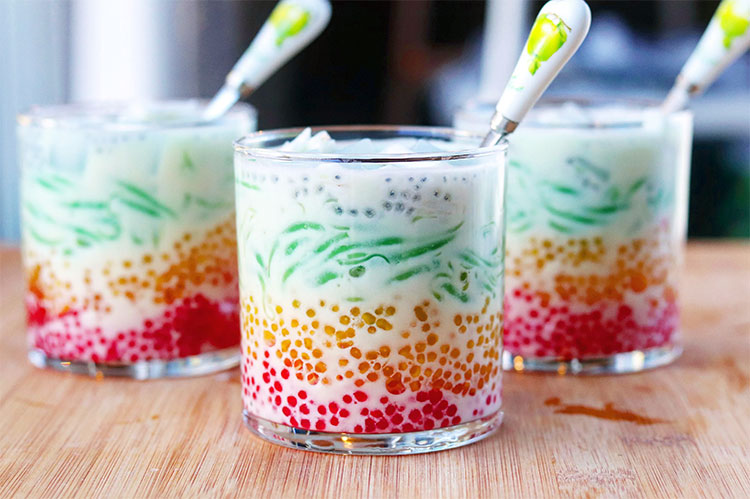Last Updated on September 16, 2022
If you’ve ever wondered how to make nab vam, this recipe will show you how. You can use the Vietnamese, Hmong, or even American versions. There are many benefits to each of these, and you can use your own recipe to learn how to make it the Vietnamese way. You’ll find that the process is quite similar to making a traditional Vietnamese noodle dish, which is why you should try it out for yourself.
INGREDIENTS
—–Coconut Syrup—–
2 lb 4oz palm sugar
1 cup water
2 (33.8 oz) coconut milk
1 1/2 tsp salt
2 pandan leaves
—–Tapioca pearls—–
3 quarts water
1 (16oz) bag tapioca pearls
Red and yellow food coloring
—–Cendol—–
1 (12oz) packet steamed pork rice flour cake mix (bot banh gio mix)
3 Tbsp tapioca starch
3 oz fresh pandan leaf
10 cups water (divide into 4 cups & 6 cups)
1/2 tsp salt
2 Tbsp pandan flavoring/extract
—-Other toppings—–
1/4 cup basil seeds
Coconut jelly
Fresh coconut meat
Fresh Coconut water (optional)
INSTRUCTIONS
- COCONUT SYRUP
Place the palm sugar in a pot with 1 cup of water. Melt the sugar on low heat until fully dissolve. Then add in the coconut milk, pandan leaves, and salt. Stir and let it simmer (but not to a boil) for 10 minutes. Turn off heat and let it cool in the fridge overnight or until fully cooled. - COOKING THE TAPIOCA PEARLS
In a pot, add in 3 quarts of water. Let it come to a boil. Then add in the tapioca pearls and stir. Stir and boil for 5 minutes. Then turn off heat, cover the pot with a lid and let it sit in the hot water for 15 minutes. After 15 minutes the pearl will double in size and become clear. Strain and rinse the pearls with cold water. Separate the pearls into two batches. Color one batch red and the other yellow. Set aside. - MAKING THE CENDOL
Chop the pandan leaves into 1 inch pieces. Place it in the blender with 4 cups of water. Blend until the pandan are well chopped and the water is a nice green color. Grab your cooking pot and place a strainer and then a fine cloth or a cheese cloth over the strainer. Strain it well and press all the liquid out. Discard the pandan pulp.Finish adding in the addition 6 cups of water into the pandan water. Then add in the packet of flour mix, 3 Tbsp of tapioca starch, and salt. Mix well.Cook the mixture over medium high heat until it becomes thick. STIR CONSTANTLY to prevent lumps from forming and to prevent the starches from burning at the bottom. Stir and cook for about 10-15 minutes. Once it becomes thick and unison, cook it for another 5 minutes. Once the batter creates a nice ribbon consistency and is shiny, take it off the heat.
Get your bucket of ice water and cendol press ready. Grab another person to help you and place the cendol press over the ice water and then fill your cendol press with the batter. The batter will fall easily into the water without you having to press it. This is a good sign you did the batter right. The strands should be about 2- 2 1/2 inches long. Finish using all the batter.
- OTHER TOPPINGS
Basil seeds: Add 1/4 cup basil seed to a bowl. Add in cold water just to cover. Let it bloom (takes about 2-4 minutes). Strain excess water and use as desire.
Coconut meat/water: Cut open a fresh coconut. Keep the water and scrape off the coconut meat. Cut the meat into bite size pieces and top naab vaam with it. - ASSEMBLE
In a cup, add equal part tapioca pearls and cendol. Add in basil seeds and the toppings. Then add in the coconut syrup to your liking. Mix. Taste and adjust. Add in ice if you want it colder.
You can also mix everything in a big bowl or container if you plan on bringing it to a big party or have them self-serve themselves.
Vietnamese way of making nab vam
The Vietnamese love to eat nab vam, a popular Thai dessert. While nab vam is popular throughout Southeast Asia, it is also enjoyed in their home country. This delicious dessert takes about 2 hours to prepare and cook. It is visually appealing and is sure to satisfy your sweet cravings. There are several basic ingredients you need to make this delicacy at home. These include yellow mung beans, pandan extract, and sugar. You will need to boil all of these ingredients until they are combined, stir them together and chill them for two hours.
Hmong way of making nab vam
The Hmong way of making nap vam is a refreshing, tri-colored drink. It is a blend of coconut milk, cassava starch noodles, and diced cantaloupe and papaya. It also contains flavored gelatin cubes and tapioca pearls. In the US, this dessert is usually called Tri-Color.
The Hmong cook their tri-color dessert in a stew pot, usually with lemongrass, chicken, and coconut milk. They also add other ingredients like chili and lime to the recipe. Hmongs often serve this dish with rice, so they can eat it as a meal. It is a hearty dish and a staple for the Hmong. It is a delicious, simple dish to make and enjoy!
While the Hmong have a great understanding of herbal medicines, most of their households maintain their own small herbal gardens. Women are often the experts when it comes to herbal medicine, and they often combine herbs and massages to help their family heal. In the process of healing a stomach ache, the Hmong use herbs and massages together. While the Hmong are not known for their Western medicine, their traditional knowledge of herbs is invaluable.
Traditionally, a prospective Hmong groom must secure a go-between who will negotiate with the young woman’s family for a high bridal price. This fee is usually paid in silver bars. Traditionally, marriages were made public with a two-day feast featuring a roasted pig, symbolically uniting the bride’s clan with that of the groom. In modern times, couples may elope instead of completing the traditional process. However, it is also common for couples to disagree over the bridal price.
Traditional Hmong marriage practices have changed quickly in the United States. Hmong culture still maintains the belief in reincarnation. They believe that every child is a reincarnated soul. They consider a child as officially joining human society within three days of birth. Children that die before these three days are not mourned. At this time, a shaman evokes the soul into the baby’s body. Living members of the family also bless the new incarnation. The newly reincarnated soul is supposed to wear a silver necklace to protect it from wandering.
The Hmong way of making nap vam has evolved alongside the American economy. In addition to producing high-quality handicrafts, the Hmong have adapted to American economic conditions by incorporating traditional handicrafts into their culture. Traditional needlecrafts, such as paj ntaub, have been practiced by Hmong women for centuries. These pieces of Hmong art are made entirely by hand without the use of measuring instruments.
The Hmong way of making nap vam is different from the way the Vietnamese or the Chinese make it. White Hmong people write their words using the Romanized Popular Alphabet. The final consonant of a word is not pronounced; the final consonant indicates the tone of the voice. The Hmong language is still relatively new in the United States, but there are still some Hmong traditions and languages that have survived over the centuries.
About The Author

Wendy Lee is a pop culture ninja who knows all the latest trends and gossip. She's also an animal lover, and will be friends with any creature that crosses her path. Wendy is an expert writer and can tackle any subject with ease. But most of all, she loves to travel - and she's not afraid to evangelize about it to anyone who'll listen! Wendy enjoys all kinds of Asian food and cultures, and she considers herself a bit of a ninja when it comes to eating spicy foods.

